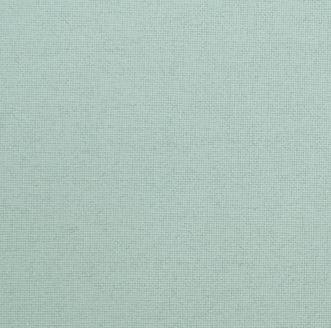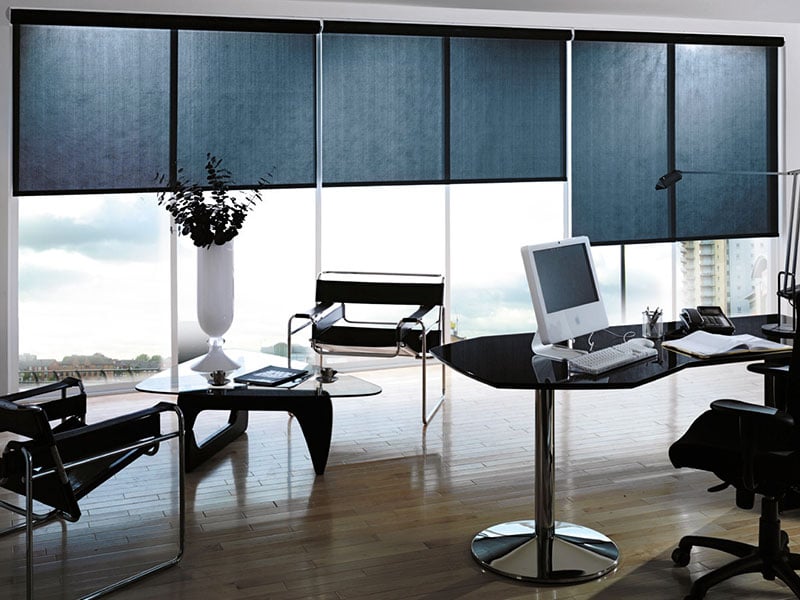Before choosing the roller blinds that you will install in a commercial building, there are several factors to consider including: the control system, hardware, accessories, and fabrics.

What fabrics are best for commercial roller shades?
When it comes to light filtering, there are 3 different types of fabric such as standard fabrics, dim-out fabrics and blackout fabrics. The dim-out fabrics are energy saving fabrics with a reflective coating bonded to a soft cloth backing, engineered to reduce the glare.
What fabric properties should you consider?
The material composition and the way fabric were treated also matter when you decide to buy roller blinds. Antibacterial technologies are very relevant to textile applications as the fabric structure makes it an attractive environment for microbes. When deciding to install blinds in hospitals and medical centers, technical standards, and certifications such as GREENGUARD and Oeko-Tex Certifications and anti-microbial properties should be considered.
Anti-microbial fabric:
Anti-microbial fabric is treated in a way that permanently kills and inhibits the growth of viruses and bacteria. This helps to keep your fabric smelling fresh and reducing the risk of potentially spreading the microbes.
Some fabrics have antimicrobial properties that contribute to protecting the fabric against the growth of fungus and bacteria, but they do not protect users against other disease-causing microorganisms. Nevertheless, commercial fabrics are treated with chemical substances like biocides, intended to exert a controlling effect on any harmful organism, including undesirable bacterial and fungal infection.
What makes anti-microbial fabrics effective for interiors, is that microbes can be trapped in fabric like upholstered furniture, carpets, blinds, and curtains. The biocide protects the user from micro-organisms while protecting the textile from bio-deterioration. Any anti-microbial treatment incorporated within a textile, besides being efficient against micro-organisms, must be non-toxic to the consumer and to the environment.
Applicable areas: healthcare, education, and hospitality
Other innovative technologies have been also applied in textiles, including fire-resistance and waterproof features.
Waterproof Fabrics:
Made from PVC. These fabrics are perfect for wet areas as they are very easy to clean with wipes. Available also with blackout fabrics they can be also used in bedrooms for complete privacy.
Applicable areas: healthcare, education, and hospitality
Fire Retardant Fabrics:
Commercial fabrics with fire-resistant materials feature an extra layer of protection to prevent fire from spreading across the windows. Fire retardant fabrics are enhanced with inherently fire-resistant fibers. There is a legal requirement for commercial blinds to be flame retardant and fire resistant. Most of buildings require blinds suppliers to install only tested fire-retardant window shades.
Roller Shades made with FR fabrics, Installed at Al Mankhool Hotel, Dubai
Polyester are naturally fire-resistant fabrics, as they are inherently resistant to catching fire. Materials like cotton or linen need to be treated with chemicals to improve their flame-retardancy, making them fire-retardant fabrics.
Designed for commercial environments, blinds fabrics should have FR certifications NFPA 701 (US) or BS 5867 (UK) and therefore they can be installed in various commercial areas such as hotels, schools, offices, care homes and hospitals.
Greenguard Certified Fabrics
This will give to blind suppliers a competitive advantage by providing a health-focused product that meet the world’s most rigorous chemical emissions testing standards. Blinds that are Greenguard certified for low chemical emissions can provide healthier environments whether indoor or outdoor.
OEKO-TEX Certified Fabrics:
OEKO-TEX® certified fabrics are fabrics that have been certified free from hazardous chemicals and are therefore considered safe.
The most common certification is the Oeko Tex 100 Standard and furnishing fabrics should meet the strict limit values for harmful substances of STANDARD 100 which covers several hundred of harmful substances including pesticides and carcinogenic colorants.

Other factors like hardware, operating and control system are essential too and will be discussed in a new blog topic.
.png?width=311&height=92&name=Euro%20Systems%20UK%202%20(1).png)

.jpg)